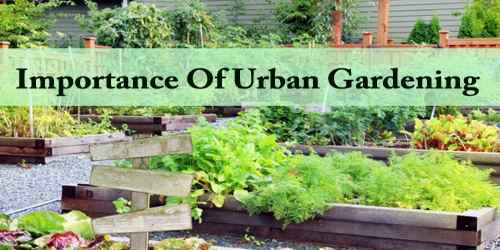Urban Gardening, also known as urban agriculture or urban farming is experiencing a boost in popularity that started several decades ago. Actually, urban gardening is the practice of cultivating, processing, and distributing food in or around urban areas. It’s now recognized and accepted as a way to experience a variety of environmental, economic, and social benefits. A lot of people from entrepreneurs and community leaders to the general public have taken note.
Basically, it is the traditional cultivation of crops, but in urban centers. Urban gardening can also involve animal husbandry, aquaculture, agroforestry, urban beekeeping, and horticulture. These activities occur in peri-urban areas as well, and peri-urban agriculture may have different characteristics.
With urbanization and since more and more people would like to do their farming where they are, urban gardening is considerably being taken up and has been a successful alternative a shift from the traditional thinking that the cultivation of crops can only be done in the rural areas.
Urban agriculture can reflect varying levels of economic and social development. It may be a social movement for sustainable communities, where organic growers, “foodies,” and “locavores” form social networks founded on a shared ethos of nature and community holism. These networks can evolve when receiving formal institutional support, becoming integrated into local town planning as a “transition town” movement for sustainable urban development. For others, food security, nutrition, and income generation are key motivations for the practice. In either case, more direct access to fresh vegetables, fruits, and meat products through urban agriculture can improve food security and food safety.
Some of the first evidence of urban agriculture comes from Mesopotamia, where farmers set aside small plots of land for farming within the city’s walls. And, although the Hanging Gardens of Babylon, one of the 7 wonders of the ancient world, have never been found, there is lots of historical evidence that elaborate gardens and irrigation systems were integrated into several ancient Mesopotamian citadels.
In ancient Egypt, fruit and nut trees were a major part of urban gardening efforts, used not only to provide shade but to provide extra subsistence and greenery within growing cities. They were also integrated into holy spaces and tombs. Aztecs built a complex garden plot and canal system, tied to their irrigation waterways, called chinampas. The chinampas started as small-scale “floating gardens” maintained by farmers, but eventually they were implemented on a large scale and within urban areas to sustain the growth of the expanding Aztec empire.
The idea of supplemental food production beyond rural farming operations and distant imports is not new. It has been used during war and depression times when food shortage issues arose, as well as during times of relative abundance. Allotment gardens came up in Germany in the early 19th century as a response to poverty and food insecurity.
From 1880 to the early 1900s, allotment gardens became a popular way for European cities like London, Paris, and Stockholm to help the urban poor become self-provisioning. In peri-urban areas, or land that immediately surrounds a city, poor families were given land to garden. This idea wasn’t unique to those European cities, however. Glowa mentioned how several urban planners, designers, and theorist connected that notion to urban farming. For instance, at the turn of the century, Ebenezer Howard’s garden city movement included gardens and larger agricultural fields within walking distance of town. Also, in the 1930s, Frank Lloyd Wright’s Broadacre City advocated for agricultural uses on each home’s one-acre allotment.
During World War I and World War II, most supplies and food were prioritized for the war effort, leaving many at home to deal with scarcity. In order to boost food supplies, many countries promoted “Victory Gardens” or “war gardens”, or gardens cultivated by citizens on private and public land. Besides alleviating the strain on the public food supply, it also was seen as a way to boost morale and patriotism. In the US, Victory gardens were responsible for about 41% of all consumed vegetable produce in the year 1943.
Today, Japan is at the forefront of innovation in urban gardening and farming. Within the urban sprawl, it’s not uncommon to find rooftop paddy fields and bee farms, vegetable gardens under the Tokyo metro, and even farms with animals taking up the entire floor of a skyscraper. Overall, urban farming in Japan has grown by 36% in the last 10 years.
The growth of plants in urban areas comes in many forms and is influenced by various factors such as land space, topography, capital requirements, and the type of plants. Urban gardening can, therefore, be done differently and includes aspects such as community gardens, urban farms, and aquaponics or hydroponics programs.
It is mainly characterized by the cultivation of crops such as fruits, vegetables, and the rearing of chicken and fish in the urban and peri-urban centers. It can be done in front and backyards, balconies, sunrooms, indoor greenhouses, rooftops, or patios. Things such as containers, old tires, barrels, unused buckets, shoes, watering cans, window-boxes or kiddie pools can be used to grow food crops, fruits plants, or flowers.
During the 1960s a number of community gardens were established in the United Kingdom, influenced by the community garden movement in the United States. The first city farm was set up in 1972 in Kentish Town, London. It combined farm animals with gardening space, an addition inspired by children’s farms in the Netherlands. Other city farms followed across London and the United Kingdom. In Australia, several city farms exist in various capital cities. In Melbourne, the Collingwood Children’s Farm was established in 1979 on the Abbotsford Precinct Heritage Farmlands (the APHF), the oldest continually farmed land in Victoria, farmed since 1838.
In 2010, New York City saw the building and opening of the world’s largest privately owned and operated rooftop farm, followed by an even larger location in 2012. Both were a result of municipal programs such as The Green Roof Tax Abatement Program and Green Infrastructure Grant Program. In Singapore, hydroponic rooftop farms (which also rely on vertical farming) are appearing.
Urban agriculture gives students an opportunity to try things out at home and more so, put their class lessons into practice. Through urban gardening, they easily connect their lessons to real-world gardening and how it is done, thereby increasing their stock of knowledge about cultivating plants.
Furthermore, school-goers who are still young can find interest in agriculture and even later pursue a course such as a degree in Agriculture when they experience cultivation through urban gardening.
Access to nutritious food, both economically and geographically, is another perspective in the effort to locate food and livestock production in cities. The tremendous influx of world population to urban areas has increased the need for fresh and safe food. The Community Food Security Coalition (CFSC) defines food security as:
“All persons in a community having access to culturally acceptable, nutritionally adequate food through local, non-emergency sources at all times.”
Areas faced with food security issues have limited choices, often relying on highly processed fast food or convenience store foods that are high in calories and low in nutrients, which may lead to elevated rates of diet-related illnesses such as diabetes. These problems have brought about the concept of food justice which Alkon and Norgaard (2009; 289) explain is, “places access to healthy, affordable, culturally appropriate food in the contexts of institutional racism, racial formation, and racialized geographies…. Food justice serves as a theoretical and political bridge between scholarship and activism on sustainable agriculture, food insecurity, and environmental justice.”
Social importance and creates environmental awareness – Urban gardening allows individuals to socially interact, contributing to society’s social and emotional wellbeing. It creates a sense of community participation for not only the community but also individuals and families, making community events more possible and easier to work on.
Also since it involves matters of the environment, it bolsters environmental awareness through aspects such as protecting soil fertility, ensuring air and water quality, protecting urban ecological biodiversity, rainwater harvesting, water recycling, organic waste recycling, and green-neighborhood spaces.
Urban gardening is of economic importance and creates jobs – Urban gardening can make a city’s economic base expand by creating economic activities through the production, packaging, and selling opportunities for food, vegetable, herbs, and fruit products.
As a result, jobs are created, the cost of food goes down, and people consume more quality foods. A healthy community also translates to vibrant and hardworking people who can work towards building the economy.
At the same time, considerably big urban gardens may require the services of gardening experts thus creating new jobs.
Environmental Benefits – The Council for Agricultural Science and Technology (CAST) defines urban agriculture to include aspects of environmental health, remediation, and recreation:
“Urban agriculture is a complex system encompassing a spectrum of interests, from a traditional core of activities associated with the production, processing, marketing, distribution, and consumption, to a multiplicity of other benefits and services that are less widely acknowledged and documented. These include recreation and leisure; economic vitality and business entrepreneurship, individual health and well-being; community health and well being; landscape beautification; and environmental restoration and remediation.”
Modern planning and design initiatives are often more responsive to this model of urban agriculture because it fits within the current scope of sustainable design. The definition allows for a multitude of interpretations across cultures and time. Frequently it is tied to policy decisions to build sustainable cities.
Urban farms also provide unique opportunities for individuals, especially those living in cities, to get actively involved with ecological citizenship. By reconnecting with food production and nature, urban community gardening teaches individuals the skills necessary to participate in a democratic society. Decisions must be made on a group-level basis in order to run the farm. Most effective results are achieved when residents of a community are asked to take on more active roles in the farm.
Actually, urban gardening allows individuals to socially interact, contributing to society’s social and emotional wellbeing. It creates a sense of community participation for not only the community but also individuals and families, making community events more possible and easier to work on.
Also since it involves matters of the environment, it bolsters environmental awareness through aspects such as protecting soil fertility, ensuring air and water quality, protecting urban ecological biodiversity, rainwater harvesting, water recycling, organic waste recycling, and green-neighborhood spaces.
Urban gardening guarantees the consumption of healthy foods that are predominantly organic, “home-grown,” and free of artificial fertilizers, pesticides, and herbicides. In other words, it gives you and your family control of the nutrients you get from your food.
Aside from healthy foods, urban gardening has an element known as “horticulture therapy,” which is reported to enhance plant-human relationships that considerably reduces stress, blood pressure, anger and fear, and muscle tension by inducing relaxation.
Information Sources:
















